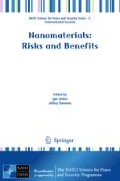Abstract
Health risks associated with inhalation of airborne particles are known to be influenced by particle sizes. A reliable, size resolving sampler, classifying particles in size ranges from 2 nm—30 μm and suitable for use in the field would be beneficial in investigating health risks associated with inhalation of airborne particles. A review of current aerosol samplers highlighted a number of limitations. These could be overcome by combining an inertial deposition impactor with a diffusion collector in a single device. The instrument was designed for analysing mass size distributions. Calibration was carried out using a number of recognised techniques. The instrument was tested in the field by collecting size resolved samples of lead containing aerosols present at workplaces in factories producing crystal glass. The mass deposited on each substrate proved sufficient to be detected and measured using atomic absorption spectroscopy. Mass size distributions of lead were produced and the proportion of lead present in the aerosol nanofraction calculated and varied from 10% to 70% by weight.
Access this chapter
Tax calculation will be finalised at checkout
Purchases are for personal use only
Preview
Unable to display preview. Download preview PDF.
References
Brown J. S., Kirby L. Z. and William D. B. (2002) Ultrafine particle deposition and clearance in the healthy and obstructed lung. Am J Resp Crit Care Med, 166:1240– 1247.
Cheng Y. S., Keating J. A. and Kanapilly G. M. (1980) Theory and calibration of a screen-type diffusion battery, J Aerosol Sci., 11:549–556.
Cheng Y. S. and Yeh H. C. (1980) Theory of a screen-type diffusion battery. J. Aerosol Sci. 11:313–320.
Dockery D. W., Pope C. A., Xu X., Spengler J. D., Ware J. H., Fay M. E., Ferris B. G. and Speizer F. E. (1993) An association between air pollution and mortality in six US cities. N Engl J Med 329:1753–1759.
Donaldson K., Li X. Y. and MacNee W. (1998) Ultrafine (nanometer) particle-mediated lung injury. J Aerosol Sci 29:553–60.
Ferin J. (1994) Pulmonary retention and clearance of particles. Toxicol Lett 72:121– 125.
Ferin J., Oberdorster G. and Penny D. P. (1992) Pulmonary retention of ultrafine and fine particle in rats. Am J Resp Cell Mol Biol 6:535–542.
Gorbunov B., Priest N., Jackson P. R. and Cartlidge D. (2000) Aerosol size distribution of lead at working places. J Aerosol Sci 31(Suppl. 1):S520–521.
Hart K. M. and Pankow J. F. (1994) High-volume air sampler for particle and gas sampling. 2. Use of backup filters to correct for the adsorption of gas-phase polycyclic aromatic hydrocarbons to the front filter. Environ Sci Technol 28:655–661.
Hinds W. C. (1999) Aerosol technology. Properties, Behaviour and Measurement of Airborne Particles. New York: Wiley, pp. 233–259.
John W. (2001) Size Distribution Characteristics of Aerosols. In: Aerosol Measurement. Principles, Techniques and Applications. Ed. PA Baron and K Willeke. New York: Wiley, pp. 99–116.
May K. R. (1982) A personal note on the history of the cascade impactor. J Aerosol Sci 13:37–47.
Moore M., Gorbunov B. and Williams I. (1998) A new method to study interaction of semi-volatile compounds with aerosol particles. J Aerosol Sci 29(Suppl. 1):S887–888.
Oberdorster G., Ferin J. and Lehnert B. E. (1994) Correlation between particle-size, in-vivo particle persistence, and lung injury. Environ Health Perspect 102(Suppl. 5):173– 179.
Pope C. A., Dockery D. W. and Schwartz J. (1995) Review of epidemiological evidence of health effects of particulate air pollution. Inhal Toxicol 7:1–18.
Sinclair D., Countess R. J., Liu B. Y. H. and Pui D. Y. H. (1976) Experimental verification of diffusion battery theory. J Air Poll Control Assoc 26:661–663.
Author information
Authors and Affiliations
Corresponding author
Editor information
Editors and Affiliations
Rights and permissions
Copyright information
© 2009 Springer Science + Business Media B.V.
About this paper
Cite this paper
Gnewuch, H., Muir, R., Gorbunov, B., Priest, N.D., Jackson, P.R. (2009). A Novel Size-Selective Airborne Particle Sampling Instrument (Wras) for Health Risk Evaluation. In: Linkov, I., Steevens, J. (eds) Nanomaterials: Risks and Benefits. NATO Science for Peace and Security Series C: Environmental Security. Springer, Dordrecht. https://doi.org/10.1007/978-1-4020-9491-0_17
Download citation
DOI: https://doi.org/10.1007/978-1-4020-9491-0_17
Publisher Name: Springer, Dordrecht
Print ISBN: 978-1-4020-9490-3
Online ISBN: 978-1-4020-9491-0
eBook Packages: Chemistry and Materials ScienceChemistry and Material Science (R0)

